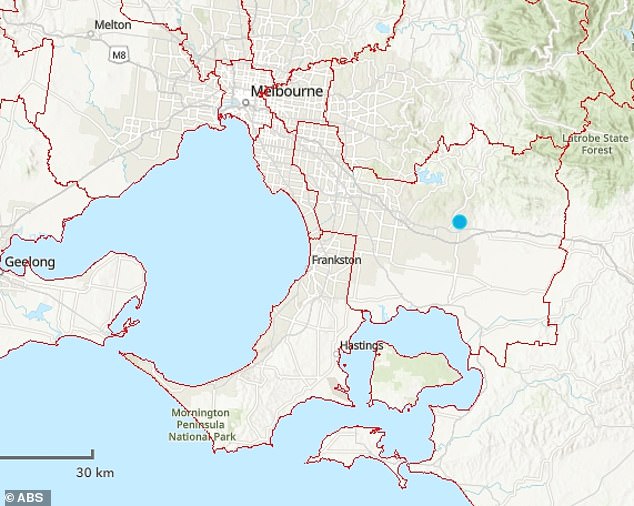The suburbs where foreigners are moving to as immigration hits a record high, rents surge
Foreigners are moving en masse to a cluster of suburbs in Sydney and Melbourne as immigration soars to a record high and apartment rents soar.
A record 454,400 people moved to Australia over the year to March, on a net basis including arrivals minus departures.
Migrants were responsible for 81 percent of the population increase of 563,200, including births, with Australia hosting 1,543 new people per day.
Sydney’s south-west, which includes Bankstown and Lakemba, took in the most migrants, along with Parramatta, a CoreLogic analysis of 2016 and 2021 Census data showed.
Melbourne’s south-east, which includes Dandenong and Pakenham, and the inner-city areas of Brunswick and Docklands, are also home to a higher number of new migrants.
The data comes as rents in the capital rose 14.9 percent in the year to August, but the pain was even worse in May, when leasing costs rose at a record annual rate of 16.5 percent.
A CoreLogic analysis of 2016 and 2021 Census data showed inner south-west Sydney, which includes Bankstown and Lakemba, recorded the most migrants, along with Parramatta, based on Australian Bureau of Statistics map areas.

Melbourne’s south-east, which included Dandenong and Pakenham, and the city’s inner area, which together with Brunswick and Docklands covered the city centre, also hosted a higher proportion of new migrants.
The number of permanent and long-term overseas arrivals to Australia has doubled in a year, thanks to more international students and skilled migrants since Australia’s borders reopened in December 2021.
That is based on 681,000 arrivals before departure.
CoreLogic economist Kaytlin Ezzy said existing renters felt the pressure as immigration rose.
“The majority of recent long-term arrivals are more likely to rent buy,” she said.
‘The impact of this additional demand is already visible on the rental market, with unit rental prices in capital cities reaching a new record high year-on-year.’
Ms Ezzy said rents were likely to continue rising at a rapid pace as more foreign migrants arrived.
‘Although the deterioration in rent affordability in recent months has slowed the pace of unit rental growth, rents are likely to remain high for some time to come, especially as net overseas migration is expected to remain high in 2023 and 2024 ‘, she said.
CoreLogic estimated that units make up 25.9 percent of the national housing stock, but this rose to 30.4 percent in Australia’s capital cities, up from 22.9 percent in 2010.
Ms Izzy said Australia will increasingly rely on more apartments to house a growing population.
“The medium to high density sector is increasingly becoming an important tool in providing additional housing stock for Australia’s growing population, especially as households continue to congregate in metropolitan areas,” she said.
Possible rate cuts in 2024 could also lead to a rise in apartment prices – something that did not happen in 2021, when the record 0.1 per cent Reserve Bank rate boosted house prices but not unit values.

Foreigners are moving en masse to a cluster of suburbs in Sydney (pictured Lakemba in the city’s south-west) and Melbourne, as immigration soars to record levels and rents skyrocket
“Right now, a larger pipeline of units under construction, high interest rates and low consumer confidence could dampen unit demand and price growth,” Izzy said.
“But once the pipeline is completed, Australia will be faced with a relatively low number of approved projects, which could create a temporary vacuum in the supply of new units.
“With cash rates set to ease in 2024, higher buying demand at this time could trigger a stronger price increase in the unit market.”
Sydney’s average unit price of $822,145 is significantly higher than Melbourne’s $603,642.
But parts of Sydney’s inner south-west are more affordable, with Lakemba having an apartment price of $424,555, which is significantly cheaper than Hornsby’s $686,346.
Australia’s national vacancy rate was just 1.2 per cent in August, data from SQM Research shows.
Average weekly apartment rent in Sydney rose 20.4 per cent in a year to $666 per week on September 12, while equivalent costs in Melbourne rose 17 per cent to $527.
NSW Premier Chris Minns has proposed building more apartment towers to accommodate the growing population.
“Not everyone will like this, but to solve the housing crisis we need to build, not just build out – and that’s exactly what we’re doing,” he tweeted in August.
The new apartment towers are rising in Sydney’s western suburbs, but not in the wealthy eastern suburbs close to the city.
Nicky Williamson asked whether wealthy postcodes across Sydney Harbor would build more apartment towers.
“Vaucluse and Mosman will want to do their bit too, right?”

